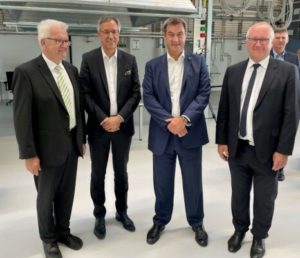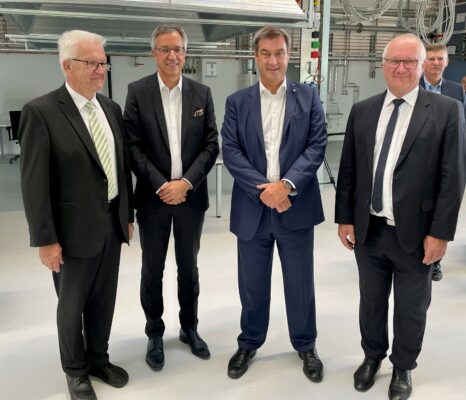On 29 August, the Minister Presidents Dr Markus Söder and Winfried Kretschmann visited the Centre for Solar Energy and Hydrogen Research Baden-Württemberg (ZSW) in the Ulm Science Park in the run-up to their joint press conference on hydrogen in Neu-Ulm, Bavaria. A unique fuel cell model factory (HyFaB) is currently being built there. Here, experts are developing the necessary conditions and processes for the large-scale production of fuel cells. More than 80 million euros are to be invested in this project by 2030, which is intended to accelerate the incipient production and market ramp-up of this emission-free, hydrogen-based drive technology. The HyFaB research factory is open to the commercial vehicle/automotive and fuel cell supplier industries as well as to companies from the mechanical and plant engineering sectors.
Funded by the state of Baden-Württemberg and the Ministry of Digital Affairs and Transport in Berlin, the HyFaB research factory at the ZSW in Ulm is a globally unique model factory that allows individual process steps for different fuel cell stack designs or manufacturers to be developed independently of each other. In addition to manufacturing processes, skilled workers are also to be qualified and industry knowledge generated. All this provides the basis for developing a future field of climate-friendly mobility based on green hydrogen.
“Hydrogen and fuel cell technologies will play a key role in the further restructuring of energy systems with a far-reaching conversion to innovative and low-emission technologies. We must therefore now create the basis for securing the supply of this energy carrier in southern Germany for the future. In doing so, Baden-Württemberg and Bavaria are joining forces to further strengthen themselves as technology locations for hydrogen and fuel cells. Our renowned research and development institutions, such as the ZSW, as well as the high technological competence and innovative strength of our companies offer excellent opportunities for this. In this way, we secure jobs and open up new sales opportunities outside Europe as well,” said Minister President Winfried Kretschmann.
Minister-President Dr. Markus Söder: “The south is becoming a hydrogen region: Bavaria and Baden-Württemberg are founding a hydrogen alliance. We have the highest competences for the energy carrier of the future. We are bundling our cooperation on a joint platform. Together we are investing almost one billion euros in research and development. The southern countries urgently need to be connected to the European hydrogen network. So far, unfortunately, plans are only being made in the north. The federal government must change that. We have the competence, that’s why we need the connection. The German performance heart lies in the south. If the southern German engine doesn’t run, then Germany has a problem. Both countries want to strengthen renewable energies even more. Hydrogen is one of the central elements of the future. We are the hydrogen tandem of the South.”
Fuel cells close to series production (HyFaB)
“All the major fuel cell companies in Germany have been partners and customers of the ZSW for many years. It is precisely for them that we have invested massively in expanding test capacities over the last 18 months together with the state of Baden-Württemberg. In addition, there is the new HyFaB production hall and the seminar wing, both of which are currently under construction. We are very pleased that we were able to give the Minister Presidents of Bavaria and Baden-Württemberg a little of the spirit of optimism about fuel cells today,” says Professor Markus Hölzle, who heads the activities of the ZSW at the Ulm site.
The ZSW in Ulm has been researching fuel cells for over 30 years. Today it operates two major research facilities: Europe’s largest independent fuel cell test field and one of the three leading independent hydrogen quality laboratories (HyLaB) worldwide. As a partner to industry, the institute supports all major developers of fuel cell drives and fuel cell stacks. In parallel, the scientists are working in research programmes on the further optimisation of existing components, more cost-effective manufacturing processes or even completely new high-performance fuel cells. This covers a wide power range from a few milliwatts up to 200 kilowatts.
HyFaB supports large and small companies in ramping up production of PEM fuel cell stacks. In addition to the actual production and quality testing of fuel cell stacks, the aim is to qualify the skilled workers of tomorrow in particular. The federal government has earmarked project funding of up to 30 million euros for this purpose over the next few years. In addition to the ZSW, the Fraunhofer ISE from Freiburg and the Fuel Cell Working Group of the German Engineering Federation (VDMA) are also involved in the HyFaB project. The Ministry of Economics is funding the new buildings at the ZSW with around 18 million euros.
Fuel Cell Centre Southern Germany
Almost all important producers of fuel cells and their components are located in southern Germany, which is why the two federal states of Baden-Württemberg and Bavaria are so important. The production of fuel cell systems is ideally suited to the medium-sized industry in these states, which is dominated by the automobile industry, and thus offers an ideal perspective for the time after the combustion engine.
The first fuel cell-powered trucks from German production will be available from 2024. With short refuelling times and long ranges of up to 1,000 kilometres, they offer an ideal future alternative for heavy-duty transport. It is now up to policymakers to shape the framework conditions in such a way that fuel cell drives, together with the necessary filling station infrastructure, can develop quickly and spread in the market.
European hydrogen plans until 2030
The future of green hydrogen in Germany and Europe is, however, crucially linked to the expansion of the renewable energies needed to produce it. More renewables in Germany offer more potential for domestic production. But it is also clear: as things stand at present, we will still have to import energy, not least – or rather first and foremost – hydrogen and its derivatives. How high the import shares will be in 2030 cannot be determined exactly today. Nevertheless, Germany and Europe must and can already actively shape the emerging global markets today.
The EU hydrogen strategy adopted on 8 July 2020 envisages that renewable hydrogen and its synthetic derivatives such as e-kerosene will be used on a large scale in all sectors that are difficult to decarbonise, such as industry and aviation, heavy goods vehicles and shipping, as early as 2030. This in turn will massively drive the need for fuel cells, especially in the latter two sectors.Exchange on the topics of hydrogen and fuel cells in Ulm: Minister President Winfried Kretschmann, ZSW Board Member Professor Markus Hölzle, Minister President Markus Söder, ZSW Board Member Professor Michael Powalla (from left to right). Photo: ZSW

